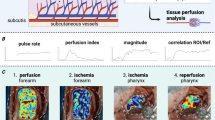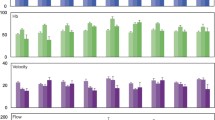Abstract
The objective of the present investigation was to study the early metabolic consequences of either arterial (AI) or venous (VI) ischemia in experimentally constructed skin flaps. It was of specific interest to evaluate whether a microdialysis monitor could discriminate between conditions where either a vein or an artery was clamped. For that purpose, bilateral buttock skin flaps were elevated on 13 pigs. One side of the pig served as AI model, and the opposite side as VI model. The ischemic period lasted 2 h. Microdialysis catheters were introduced into the flap tissue of both sides and also into an unoperated control area. This made it possible to measure and compare glucose, lactate, and glycerol concentrations in flap and control tissue. Metabolic consequences of ischemia could be evaluated by determining changes in the interstitial concentrations of these substances before, during, and after AI and VI. To verify cessation and reinstitution of blood flow during vascular occlusion and reperfusion, laser Doppler monitoring (LDF) and clinical assessment were used in parallell with microdialysis. The glucose level fell significantly in response to both AI and VI (P<0.01 and P<0.01, respectively), whereas the corresponding lactate and glycerol levels increased significantly (P<0.01 and P<0.05, respectively). The glucose response to AI did not differ significantly from that obtained in response to VI. Significantly higher concentrations of lactate and glycerol were, however, observed during AI as compared with VI (P<0.05 and P<0.05, respectively). In conclusion, this study shows that microdialysis rapidly detects metabolic changes inside a newly raised pig buttock flap. The study also shows that the microdialysis technique is capable of discriminating between arterial and venous occlusion. Significantly higher lactate and glycerol levels during AI than during VI indicate that the clinically observed more deleterious effects of VI are not reflected metabolically in this study. Whether this is a consequence of the relatively short occlusive period or due to other factors, such as capillary damage during VI, needs further elucidation.
Similar content being viewed by others
Author information
Authors and Affiliations
Additional information
Received: 5 August 1999 / Accepted: 11 December 1999
Rights and permissions
About this article
Cite this article
Röjdmark, J., Hedén, P. & Ungerstedt, U. Comparison of flap ischemia induced by arterial or venous occlusion in pigs with the aid of microdialysis. E J Plastic Surg 23, 278–282 (2000). https://doi.org/10.1007/s002380000128
Issue Date:
DOI: https://doi.org/10.1007/s002380000128




